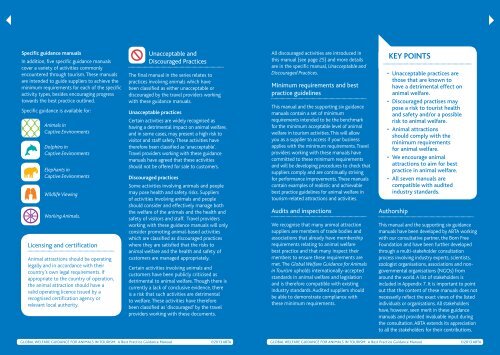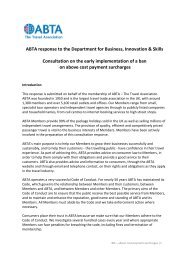You also want an ePaper? Increase the reach of your titles
YUMPU automatically turns print PDFs into web optimized ePapers that Google loves.
Specific guidance manualsIn addition, five specific guidance manualscover a variety of activities commonlyencountered through tourism. These manualsare intended to guide suppliers to achieve theminimum requirements for each of the specificactivity types, besides encouraging progresstowards the best practice outlined.Specific guidance is available for:Animals inCaptive EnvironmentsDolphins inCaptive EnvironmentsElephants inCaptive EnvironmentsWildlife ViewingWorking Animals.Licensing and certificationAnimal attractions should be operatinglegally and in accordance with theircountry’s own legal requirements. Ifappropriate to the country of operation,the animal attraction should have avalid operating licence issued by arecognised certification agency orrelevant local authority.Unacceptable andDiscouraged PracticesThe final manual in the series relates topractices involving animals which havebeen classified as either unacceptable ordiscouraged by the travel providers workingwith these guidance manuals.Unacceptable practicesCertain activities are widely recognised ashaving a detrimental impact on animal welfare,and in some cases, may present a high risk tovisitor and staff safety. These activities havetherefore been classified as ‘unacceptable’.Travel providers working with these guidancemanuals have agreed that these activitiesshould not be offered for sale to customers.Discouraged practicesSome activities involving animals and peoplemay pose health and safety risks. Suppliersof activities involving animals and peopleshould consider and effectively manage boththe welfare of the animals and the health andsafety of visitors and staff. Travel providersworking with these guidance manuals will onlyconsider promoting animal-based activitieswhich are classified as discouraged practiceswhere they are satisfied that the risks toanimal welfare and the health and safety ofcustomers are managed appropriately.Certain activities involving animals andcustomers have been publicly criticised asdetrimental to animal welfare. Though there iscurrently a lack of conclusive evidence, thereis a risk that such activities are detrimentalto welfare. These activities have thereforebeen classified as ‘discouraged’ by the travelproviders working with these documents.All discouraged activities are introduced inthis manual (see page 25) and more detailsare in the specific manual, Unacceptable andDiscouraged Practices.Minimum requirements and bestpractice guidelinesThis manual and the supporting six guidancemanuals contain a set of minimumrequirements intended to be the benchmarkfor the minimum acceptable level of animalwelfare in tourism activities. This will allowyou as a supplier to access if your businessapplies with the minimum requirements. Travelproviders working with these manuals havecommitted to these minimum requirementsand will be developing procedures to check thatsuppliers comply and are continually strivingfor performance improvements. These manualscontain examples of realistic and achievablebest practice guidelines for animal welfare intourism-related attractions and activities.Audits and inspectionsWe recognise that many animal attractionsuppliers are members of trade bodies andassociations that already have membershiprequirements relating to animal welfarebest practice and that many inspect theirmembers to ensure these requirements aremet. The Global Welfare Guidance for Animalsin Tourism upholds internationally-acceptedstandards in animal welfare and legislationand is therefore compatible with existingindustry standards. Audited suppliers shouldbe able to demonstrate compliance withthese minimum requirements.KEY POINTS• Unacceptable practices arethose that are known tohave a detrimental effect onanimal welfare.• Discouraged practises maypose a risk to tourist healthand safety and/or a possiblerisk to animal welfare.• Animal attractionsshould comply with theminimum requirementsfor animal welfare.• We encourage animalattractions to aim for bestpractice in animal welfare.• All seven manuals arecompatible with auditedindustry standards.AuthorshipThis manual and the supporting six guidancemanuals have been developed by <strong>ABTA</strong> workingwith our consultative partner, the Born FreeFoundation and have been further developedthrough a multi-stakeholder consultationprocess involving industry experts, scientists,zoologist organisations, associations and nongovernmentalorganisations (NGOs) fromaround the world. A list of stakeholders isincluded in Appendix 7. It is important to pointout that the content of these manuals does notnecessarily reflect the exact views of the listedindividuals or organisations. All stakeholdershave, however, seen merit in these guidancemanuals and provided invaluable input duringthe consultation. <strong>ABTA</strong> extends its appreciationto all the stakeholders for their contributions.GLOBAL <strong>WELFARE</strong> GUIDANCE FOR <strong>ANIMAL</strong>S IN TOURISM: A Best Practice Guidance Manual ©2013 <strong>ABTA</strong> GLOBAL <strong>WELFARE</strong> GUIDANCE FOR <strong>ANIMAL</strong>S IN TOURISM: A Best Practice Guidance Manual ©2013 <strong>ABTA</strong>



